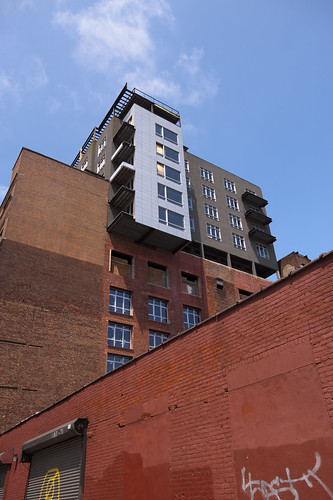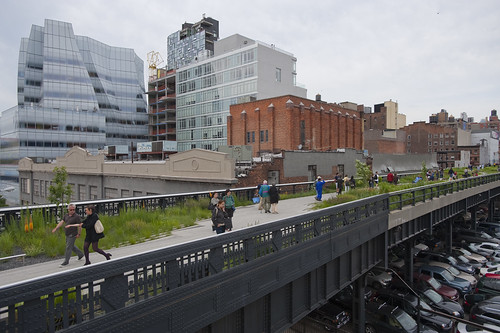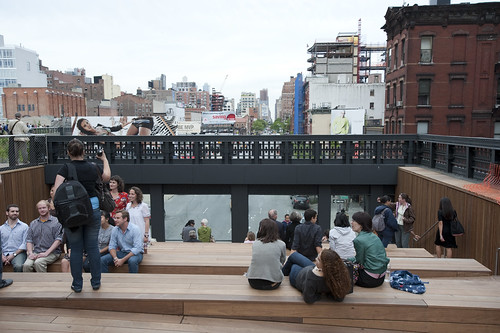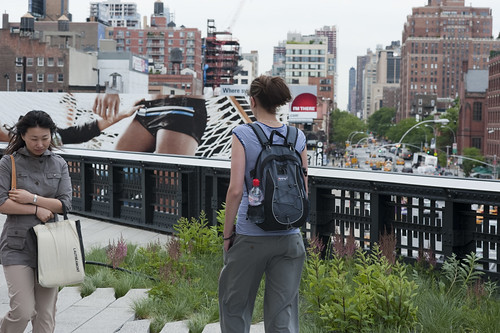


Three curious examples of a kind of infrastructural sedimentation, found in New York City and Brooklyn. The first one shows a broken portion of a (ugly) sign that had been placed over the original art deco style lettering on a behemoth post office. The next is a (ugly) fancy condominium module that has been plopped on top of an old light industrial / warehouse building in the now Tony / over-the-top section of Brooklyn’s “DUMBO” (down underneath the manhattan bridge overpass) section. Finally, The Highline, a new urban park that was found within an old abandoned stretch of train track that sits one story above ground, along the westside of Manhattan, around Chelsea-ish.
The first example of the Post Office signage feels like one of those things where an old infrastructure is long forgotten and is then revealed and someone in the office of infrastructure, or probably a local resident with a civic interest says — hey, that old art deco chiseled into that building? It’s historical! And, it’s cool type. Lets reveal it all! And someone writes a little pithy, clever blurb in the “Around Town” section of the New Yorker, interviewing someone from the company that’s going to remove the old sign. I’d put a fin down saying that’s what’ll happen within the next 2-3 years. There’ll be some revival of sorts to continue this tendency in NYC of rehabilitating and making more habitable the city and its views. In any case, the layers here are quite a stark contrast it seems. I wonder why the sign was put up in the first place. Maybe it was easier to let the sign be dirty, as it inevitably will become from the street exhausts and so forth, because of its dark background.
This second example of historical and material sediment in Brooklyn shows a somewhat ham-fisted attempt to create desirable living spaces. It’s hard to get a perspective on what this architectural retrofit is doing in the larger context. This general part of Brooklyn was both (a) the place we moved from because the schools sucked and; (b) the place we moved back to because the schools sucked so it was super cheap for a couple of recent college grads brothers to get an apartment so stymied you’d definitely never cook in, and were probably nervous about even using the shower. That part is the layer below this modular architectural denture. Above, the veneer; below the history. I have no idea what is below now — most of the old light industrial spaces were either artists studios before the mass conversion of the area and, certainly before that, manufacturing or warehouse space.
Finally, the lovely new Highline park in Manhattan. It was done over an old elevated train track that ran along roughly 10th avenue in the mid-teens and twenties, now redone as a quite habitable pedestrian park that gives a unique perspective on the city. It’s like the urban equivalent of a bottomless boat in a way. Not literally looking downward (although the seating area/amphitheater section does this along the avenue), but at the human-legible height of one-story that’s not quite high enough to give the old school WTC style press-your-face-against-the-glass-and-look-down vertigo and not quite low enough to feel like you’re just sitting on someone’s shoulders. In that spirit, the park was one of the locations used for a High POV camera shot, although we got the business and were made to talk on the phone (!) from someone with the “Friends of the Highline” group who said they don’t allow tripods or, like…high poles up in the park. Pfft. (More on that in an upcoming dispatch as soon as the guys from the Bureau of Unusual Perspectives and Alternative Vantage Points gets back from vacation.)



